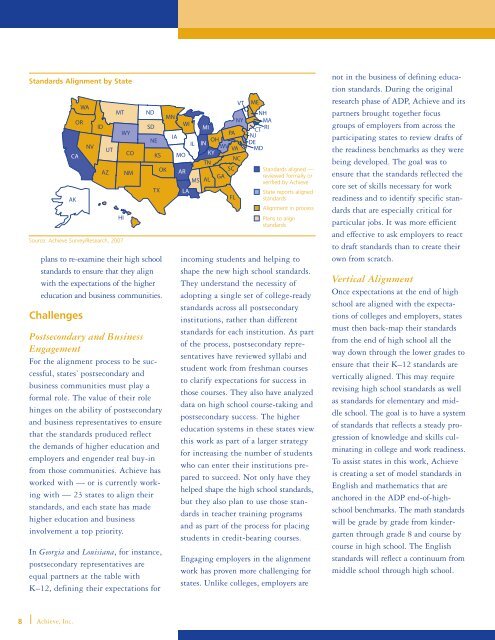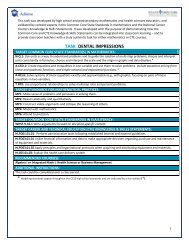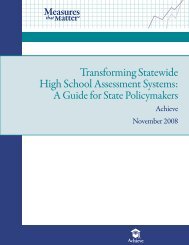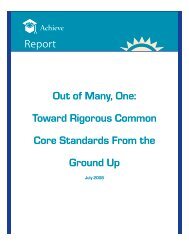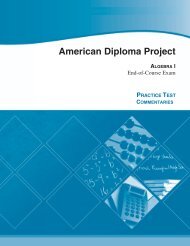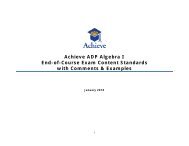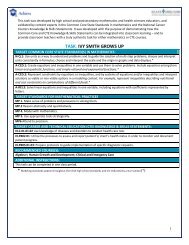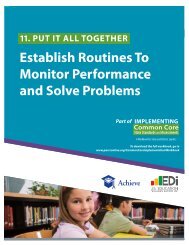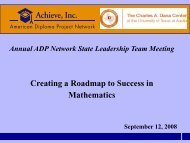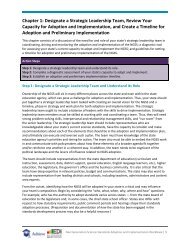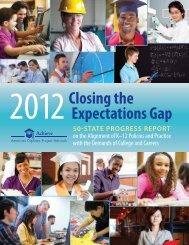Closing the Expectations Gap 2007 - Achieve
Closing the Expectations Gap 2007 - Achieve
Closing the Expectations Gap 2007 - Achieve
Create successful ePaper yourself
Turn your PDF publications into a flip-book with our unique Google optimized e-Paper software.
Standards Alignment by StateCAAKORplans to re-examine <strong>the</strong>ir high schoolstandards to ensure that <strong>the</strong>y alignwith <strong>the</strong> expectations of <strong>the</strong> highereducation and business communities.ChallengesWANVMTWYCONMPostsecondary and BusinessEngagementFor <strong>the</strong> alignment process to be successful,states’ postsecondary andbusiness communities must play aformal role. The value of <strong>the</strong>ir rolehinges on <strong>the</strong> ability of postsecondaryand business representatives to ensurethat <strong>the</strong> standards produced reflect<strong>the</strong> demands of higher education andemployers and engender real buy-infrom those communities. <strong>Achieve</strong> hasworked with — or is currently workingwith — 23 states to align <strong>the</strong>irstandards, and each state has madehigher education and businessinvolvement a top priority.In Georgia and Louisiana, for instance,postsecondary representatives areequal partners at <strong>the</strong> table withK–12, defining <strong>the</strong>ir expectations forIDAZUTHISource: <strong>Achieve</strong> Survey/Research, <strong>2007</strong>VT MENDNHMNNY MASDWIMICTRIPAIANJNEOHIL INDEWV VA MDKS MO KYNCTNOK ARSCStandards aligned —GAreviewed formally orMS ALverified by <strong>Achieve</strong>TX LAState reports alignedFL standardsAlignment in processPlans to alignstandardsincoming students and helping toshape <strong>the</strong> new high school standards.They understand <strong>the</strong> necessity ofadopting a single set of college-readystandards across all postsecondaryinstitutions, ra<strong>the</strong>r than differentstandards for each institution. As partof <strong>the</strong> process, postsecondary representativeshave reviewed syllabi andstudent work from freshman coursesto clarify expectations for success inthose courses. They also have analyzeddata on high school course-taking andpostsecondary success. The highereducation systems in <strong>the</strong>se states viewthis work as part of a larger strategyfor increasing <strong>the</strong> number of studentswho can enter <strong>the</strong>ir institutions preparedto succeed. Not only have <strong>the</strong>yhelped shape <strong>the</strong> high school standards,but <strong>the</strong>y also plan to use those standardsin teacher training programsand as part of <strong>the</strong> process for placingstudents in credit-bearing courses.Engaging employers in <strong>the</strong> alignmentwork has proven more challenging forstates. Unlike colleges, employers arenot in <strong>the</strong> business of defining educationstandards. During <strong>the</strong> originalresearch phase of ADP, <strong>Achieve</strong> and itspartners brought toge<strong>the</strong>r focusgroups of employers from across <strong>the</strong>participating states to review drafts of<strong>the</strong> readiness benchmarks as <strong>the</strong>y werebeing developed. The goal was toensure that <strong>the</strong> standards reflected <strong>the</strong>core set of skills necessary for workreadiness and to identify specific standardsthat are especially critical forparticular jobs. It was more efficientand effective to ask employers to reactto draft standards than to create <strong>the</strong>irown from scratch.Vertical AlignmentOnce expectations at <strong>the</strong> end of highschool are aligned with <strong>the</strong> expectationsof colleges and employers, statesmust <strong>the</strong>n back-map <strong>the</strong>ir standardsfrom <strong>the</strong> end of high school all <strong>the</strong>way down through <strong>the</strong> lower grades toensure that <strong>the</strong>ir K–12 standards arevertically aligned. This may requirerevising high school standards as wellas standards for elementary and middleschool. The goal is to have a systemof standards that reflects a steady progressionof knowledge and skills culminatingin college and work readiness.To assist states in this work, <strong>Achieve</strong>is creating a set of model standards inEnglish and ma<strong>the</strong>matics that areanchored in <strong>the</strong> ADP end-of-highschoolbenchmarks. The math standardswill be grade by grade from kindergartenthrough grade 8 and course bycourse in high school. The Englishstandards will reflect a continuum frommiddle school through high school.8<strong>Achieve</strong>, Inc.


